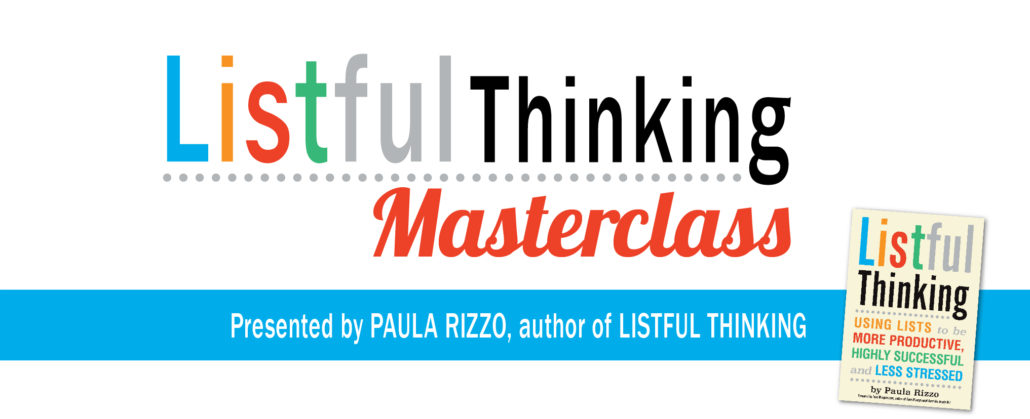Listful Thinking Turns Two!
 Do you ever get one of those Timehop things on Facebook where a picture pops up that you could’ve sworn you posted not that long ago, when it turns out it’s from two years ago!! I’m having one of those moments today as it’s been two years since my book Listful Thinking came out.
Do you ever get one of those Timehop things on Facebook where a picture pops up that you could’ve sworn you posted not that long ago, when it turns out it’s from two years ago!! I’m having one of those moments today as it’s been two years since my book Listful Thinking came out.
Where has that time gone?
I had to make a list:
- There was that time I met Marie Kondo and it sparked joy.
- My appendix exploded.
- Then I developed an online course with my friend Terri Trespicio called Lights Camera Expert to help entrepreneurs, experts and authors get and keep media attention.
- I continued to hear great feedback about a keynote speech for New York Women in Communications.
 Listful Thinking has been translated into 10 languages! The different titles and covers of the various international versions of my book all give me a small insight into the cultures they represent. A prime example of this is the Japanese cover which features an adorable robot. Plus there’s now a new language to add to the ongoing list – Korean!
Listful Thinking has been translated into 10 languages! The different titles and covers of the various international versions of my book all give me a small insight into the cultures they represent. A prime example of this is the Japanese cover which features an adorable robot. Plus there’s now a new language to add to the ongoing list – Korean!
I’m excited to announce the next step in the Listful Thinking journey. I’m launching a brand new course called Listful Thinking Masterclass. It’s designed to help you set up a real system to get more done than ever.
I’ll be personally leading the course each week to give you guidance and tackle the big issues that are stifling your productivity like distractions and procrastination. Check it out here. I can help you make this your most productive year yet!
The Stars Are Aligned For You to Get More Done Now
It’s the beginning of the new year and everyone is already fantasizing about their grand plans for 2017.
You’re in luck because this is the perfect time to get moving on your goals. Not to get too “woo woo” but Mercury Retrograde came to an end on January 8th.
So what does this mean? Well many people believe in avoiding making life-changing plans or decisions during the retrograde, because it’s a time when everything is in flux. They save all this for after the retrograde, when the chips have all fallen and you can make firm plans for the future.
Whether you believe in this theory or not, January is a great time to start planning your future. So how are you going to make this year different from all the other years?
The only way to break out of these patterns and start accomplishing our goals is to take responsibility for our role in that downfall. For example, your diet didn’t fail because a donut place opened across the street from your apartment. (Yum!) It failed because you chose to go there! (Multiple times…)
Bad habits are not just the actions we take, sometimes we can develop bad ‘thinking’ habits. So you might think failure is inevitable, which subconsciously causes you to act in a self-sabotaging manner. This ultimately allows you to prove that you were right about being a failure in the first place and continues the negative cycle. A self-fulfilling prophecy.
This year it’s important to take control and understand how you can break out of that cycle and your bad habits and get more done.
One way for you to get the most out of your day is to sign up for my webinar – “5 Habits That Are Killing Your Productivity & How to Optimize Your Time”.
It’s time to stop being ‘busy’ and time to start getting things done!
I’ll be hosting two sessions of the webinar. One on Wednesday and one Thursday at 8pm Eastern. Pick a day that works for your schedule and sign up by clicking this link.
I’ll walk you through ways to rethink how you plan out your day so you can cut down on procrastination, make more attainable goals and have time to do the stuff you really want to do.
Here’s what we’ll cover:
- How to make simple changes to your everyday routine to get more done
- Discover how you’re really spending your time and find out how to optimize it so you’re not “busy” all the time.
- Start building momentum towards the things you want most by creating a time-management system that works for you.
- Feel in control of your life and your goals instead of feeling stuck.
- Learn the quickest ways to be more efficient for free without spending tons of time
I look forward to talking to you and showing you how to get more done this year! Join me!
Why You Didn’t Get Everything Done Last Year and How to Change That
The new year brings with it hope for the future but also a little guilt as well. Guilt because we look back at the previous year and think “oh I didn’t get to do as much as I set out to do.”
It happens and it’s disappointing. And nothing reminds us more of this than looking at that unfulfilled bucket list. Or starting yet another day with the best of intentions only to get sucked into your old roommate’s vacation photos on Facebook and then getting nothing done. We all promise ourselves that next year will be different.
However that’s quite statistically unlikely, given that only 8% of people achieve their resolutions!
So how do you break out of the vicious cycle? It’s all starts with how you make these goals. Here’ are the steps you need to finally cross off some of the most difficult tasks on your list!
Imagine next year’s Christmas letter – Every year people will send out Christmas letters detailingall the exciting trips they’ve been on t and all their new jobs/houses/kids/etc. Whether or not you regularly write one of these, productivity guru and author Laura Vanderkam explains in her TED talk about time management how you can use them to focus your goals. Laura suggests you imagine what you would write on next year’s letter today. That vision includes the 3-5 key things that would have to happen for it to be a successful year. Once you have picked those things you have goals for the next year – now you just need an action plan.
Prioritize – Once you’ve picked your goals you don’t need to roar ahead, all guns blazing trying to achieve everything at once. Write out the steps you will need to take to achieve each goal and create a priority list of what is more urgent. Things that need to be started on right away, like training for a marathon, take top priority. You will need to start carving out time in your calendar for training and book your place in the race. Less important things like cleaning out the garage can wait until a later date (but this doesn’t mean you should ignore them altogether!) For an easy way to figure out how to prioritize your new goals, sign up for the FREE PDF I created for you called “Prioritize Like a Pro.”
Find the why – I wrote recently about a talk Julie Morgenstern gave, where she explained how she always used to hoard cookbooks. And she couldn’t throw them away until she understood why she kept them. The reason — she kept them because they represented the mother she wanted to be. (Isn’t that heartbreaking?) Similarly you can’t successfully do-over your goals from last year until you understand why you failed. Perhaps they were too big, or you didn’t give yourself enough time to do any of them or any research that would have helped. Sometimes you have to realize that maybe you won’t ever do it and toss the goal all together. We’re not all perfect, sometimes you have to let go of those goals you’ve never quite gotten around to and be OK with it. I, for instance will never learn to speak French. That’s one goal checked off by default!
What are some of your goals for 2017?




